Sama Dance: Unraveling the Mystical Beauty of an Ancient Dance
Sama dance, a captivating and mesmerizing form of spiritual expression, holds a prominent place in the mystical world of Sufism.
Rooted in the rich traditions of Iranian mysticism, this enchanting dance has deep spiritual significance and a history that spans centuries. The term Sama dance itself evokes a sense of transcendence and devotion, as practitioners engage in a soul-stirring whirling ritual to connect with the divine.
Join us on this profound exploration of Sama dance, as we seek to unravel its mystique and understand the transformative power it holds for those who seek a spiritual connection with the divine. In the following sections, we will venture into the heart of Sama dance, exploring its rituals, significance, and its presence across various cultures.
Definition of Sama Dance
At its core, Sama dance is a sacred practice performed by Sufi dervishes to attain a state of spiritual ecstasy, reaching towards a union with the divine. It is an art form that goes beyond mere physical movements, becoming a profound spiritual experience for both the participants and spectators alike. The central feature of Sama dance is the mesmerizing spinning or whirling of the dervishes, symbolizing a profound journey of the soul towards spiritual enlightenment.

Significance and Historical Origins
For the first time in history, we encounter "Sama" in the Shahnameh, which is defined as joyful worship, performed by Khosrow Kiani (Kay Khosrow) for five weeks.
"چنین پنج هفته خروشان به پای *** همی بود بر پیش گیهان خدای"
Translation: It was such a magnificent five weeks [performing Sama], in front of the God who created the universe.
This way and manner of praising God in a state of happiness and "spiritual Drunkenness" is not in Islamic traditions, but it is from the first Aryan culture. Therefore, Sama (Sema) and religious dance for God has its roots in the ancient, rich history of Iran.
It is not clear exactly when the formation of Sama meetings started, however, we know that Sama had a non-Islamic religious history and was used in Iranian religious places of worship in ancient times.
Fereydoon Joneidi writes in the book "Navaye Khosh-e Iran": Sufi dance is turning around oneself. This dance, which takes place along with the Daf music, is the same rotation that takes place in Gud Zoorkhane with the Zarb song, with a more regular ending. Zoorkhane and Pahlevani movements were used to prepare to fight against the enemies of the homeland, and the Sama dance was used to prepare to fight against the enemy of life (evil thoughts).
The Spiritual Roots of Sama Dance
At the heart of Sama dance lies the spiritual tradition of Sufism, a mystical dimension of mind that emphasizes the pursuit of divine love and knowledge. Sufism, often referred to as the "inner dimension" of the mind, focuses on transcending the material world and seeking a direct experience of the divine presence. It delves into the deeper meanings of the universe, emphasizing personal introspection, meditation, and devotion as the pathways to spiritual enlightenment.
Sama dance is one of the most prominent expressions of Sufi spirituality. It is believed to be a means of attaining a state of heightened consciousness, where the soul connects with the divine source. Through the rhythmic whirling and enchanting music, Sama dancers aim to transcend their physical limitations and enter a realm of spiritual ecstasy, guided by the principles of Sufi philosophy.
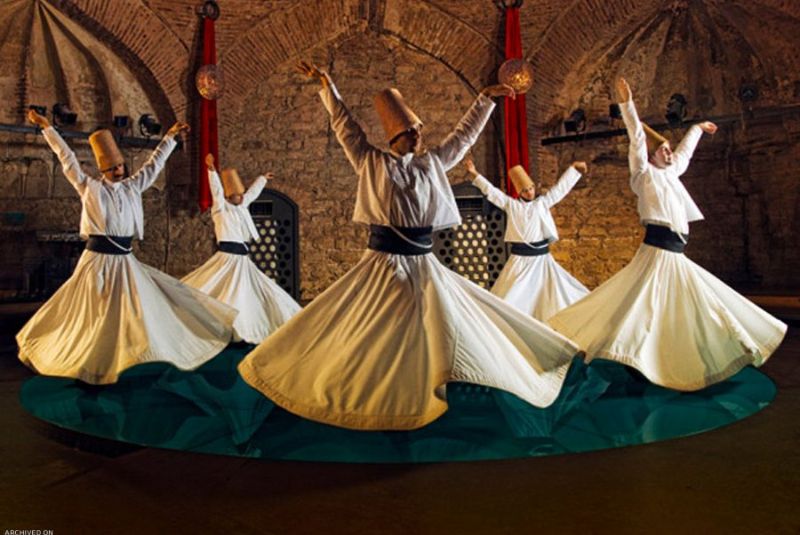
Connection to Rumi and Mevlana Jalaluddin Rumi
The origins of Sama dance can be traced back to the profound teachings of the 13th-century Persian poet and Sufi mystic, Mevlana Jalaluddin Balkhi (Romi). Known simply as Mawlānā/Molānā (Persian: مولانا Persian pronunciation: [moulɒːnɒ]), he was a prominent figure in the development of Sufi thought and poetry. Molana Rumi's teachings emphasized the path of love, unity, and tolerance, transcending religious and cultural boundaries. His spiritual journey, deeply influenced by the loss and encounter with the wandering dervish Shams Tabrizi, led to the creation of the Mevlevi Order and the practice of Sama dance.
Molana Rumi envisioned the Sama dance as a form of meditation and a way to express divine love and union with the Beloved, the Divine. He famously said, "Come, come, whoever you are. Wanderer, worshiper, lover of leaving. It doesn't matter. Ours is not a caravan of despair. Come, even if you have broken your vows a thousand times. Come, yet again, come, come."
The Philosophy of Spiritual Ecstasy through Dance
The philosophy underpinning Sama dance revolves around the concept of "mystical intoxication" or spiritual ecstasy. The whirling movement of the dervishes symbolizes the soul's yearning to break free from the earthly confines and unite with the divine essence. By spinning in harmony, the Sama dancers aim to attain a state of spiritual intoxication, where the ego dissolves, and the individual self merges with the universal consciousness.
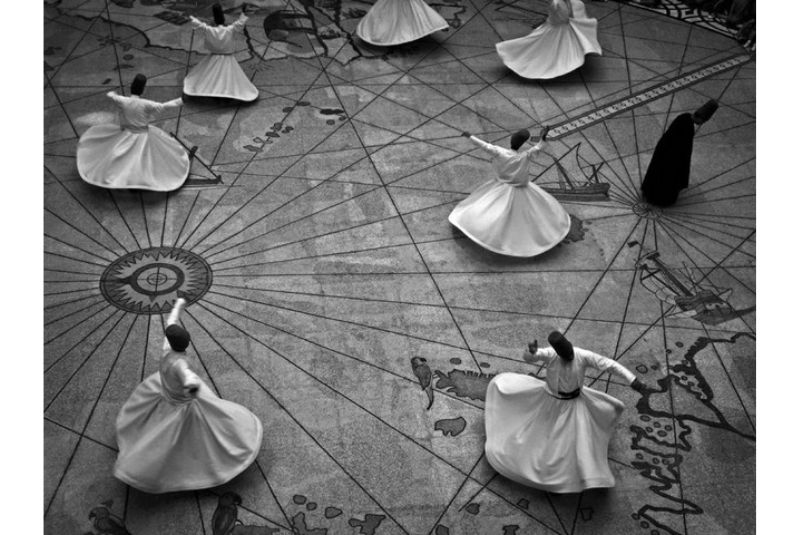
Sama dance is a ritual of devotion, a journey of the soul toward divine love and spiritual perfection. The dancer's movements echo the celestial dance of the cosmos, signifying the unity of all creation and the interconnectedness of every soul with the divine source.
In essence, Sama dance is not merely a physical performance but a profound spiritual practice that embodies the timeless wisdom of Sufi teachings. It serves as a reminder of the universal quest for love, enlightenment, and the yearning to be in harmony with the divine. As we delve deeper into the enchanting world of Sama dance, we will uncover its symbolism, rituals, and transformative power that continues to inspire spiritual seekers across the globe.
| Suggestion: Sizdah Bedar Festival
Understanding the Symbolism of Sama Dance
The Whirling Dervishes: Symbolizing Planets and Orbits
At the heart of the Sama dance lies a profound symbolism, particularly embodied by the whirling dervishes. As the dervishes spin gracefully in a counterclockwise direction, their movements hold a deep cosmic significance. The whirling motion is believed to symbolize the rotation of planets and celestial bodies in the universe, echoing the perpetual dance of the cosmos.
In this cosmic interpretation, each whirling dervish represents a celestial body, and their synchronized movements reflect the harmony and interconnectedness of the celestial spheres. Just as the planets orbit around a central axis, the Sama dancers revolve around a symbolic axis, signifying the divine source to which they are spiritually drawn. This representation of the cosmic dance reinforces the Sufi belief in the unity and interdependence of all creation, reflecting the harmony that can be achieved through a spiritual journey.
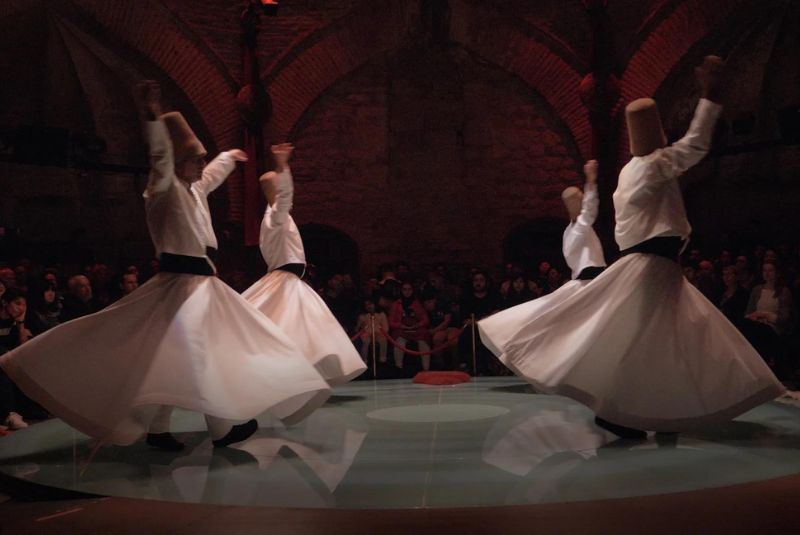
The Concept of Unity with the Divine
Sama dance is a visual manifestation of the Sufi philosophy's central tenet: the quest for unity with the divine. As the dancers whirl with focused intensity, their outstretched arms symbolize the receiving and giving of divine blessings. The right palm is turned upward to receive grace from the divine, while the left palm is turned downward to bestow that grace upon humanity.
The circular motion of the dance signifies the cyclical nature of existence and the eternal return to the divine source. Through this whirling, the dancers aim to transcend their individual selves and experience a profound sense of unity with the Creator. It is in this state of unity that the ego dissolves, and the seeker becomes absorbed in divine love, breaking free from the limitations of the material world.
| Also might be interesting: All about Iran's Haft-Sin
The Symbolism of the Dancer's Attire and Movements
The attire worn by the whirling dervishes holds symbolic significance that reflects the spiritual journey of the Sama dance. The long white robes, called "Kemar," represent the shroud of the ego and the shedding of earthly attachments. The tall conical hat, known as the "Sikke," symbolizes the tombstone, signifying the dervish's spiritual rebirth through the dissolution of the ego.
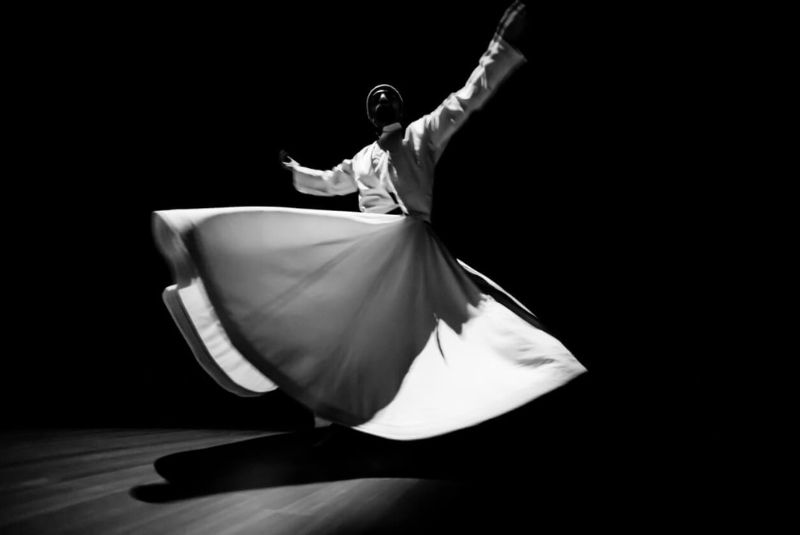
Additionally, the Sama dancer's movements are carefully choreographed to represent different stages of the spiritual journey. The initial crossing of the arms over the chest signifies the spiritual rebirth and awakening of the seeker. As the whirling intensifies, the right hand is raised towards the heavens, drawing divine energy, while the left hand is lowered towards the earth, sharing that divine energy with all of creation.
Throughout the dance, the dervishes maintain their focus on the central axis, representing their unwavering devotion to the divine. The entire performance is a spiritual expression of love and surrender, a profound meditation that allows the dancers and the audience to experience the unity and transcendence sought in Sufi practice.
In the realm of Sama dance, symbolism becomes a language that conveys the deepest spiritual truths. The cosmic dance of the whirling dervishes, the quest for unity with the divine, and the symbolism woven into every movement and attire create a mesmerizing and transformative experience that continues to captivate souls on their spiritual journey.
The Rituals and Preparation
Sama dance is intimately tied to the various Sufi orders, each of which has its distinctive traditions and rituals associated with this sacred practice. The most renowned Sufi order linked to Sama dance is the Mevlevi Order, founded by Mevlana Jalaluddin Rumi. The Mevlevi Order, also known as the Whirling Dervishes, has preserved the art of Sama dance in its purest form over the centuries.
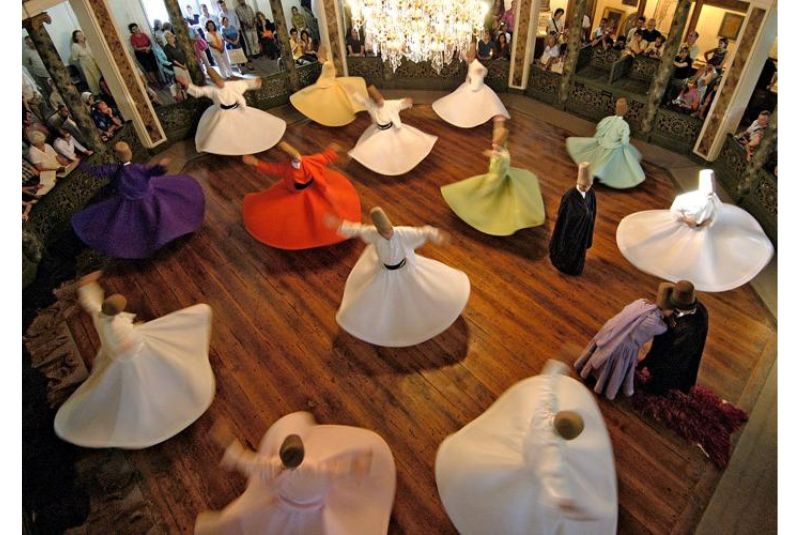
In the context of the Mevlevi Order's Sama ceremony, the ritual begins with the recitation of poems and prayers, invoking blessings and divine inspiration. The performance then proceeds with the mesmerizing whirling dance, where the dervishes enter a profound state of trance, symbolizing their spiritual journey toward divine union.
Apart from the Mevlevi Order, other Sufi orders around the world have also incorporated elements of Sama dance into their ceremonies, adapting the practice to their unique cultural and spiritual contexts. These various orders keep the tradition alive, allowing Sama dance to flourish across different regions while preserving its essence as a gateway to spiritual transcendence.
| Read more: Iranian Folkloric Dance: Cultural Delight!
Importance of Music and Rhythm
Central to the allure and spiritual intensity of Sama dance is the captivating music and rhythmic accompaniment. Traditional Sama ceremonies are accompanied by enchanting Sufi music, often featuring the soul-stirring sounds of instruments such as the ney (a reed flute), the oud (a lute-like string instrument), and the daf (a type of frame drum). The rhythmic melodies evoke a sense of spiritual ecstasy, guiding the dervishes in their whirling movements.
The music played during the Sama dance serves as a catalyst for the dancers' spiritual journey, leading them into a deeper state of meditation and devotion. The melodies are carefully structured to evoke specific emotions and facilitate the participants' connection with the divine source. The rhythm acts as a heartbeat that unites the dancers and the audience, creating a transcendent atmosphere where the boundaries between the physical and spiritual realms blur.
Spiritual Preparation and Devotion
Preparing for Sama dance involves more than just learning the physical techniques of whirling. It demands profound spiritual preparation and devotion from the dancers. Spiritual seekers who participate in Sama ceremonies undergo a period of disciplined practice, including prayer, meditation, and self-reflection, to purify their hearts and minds.
The intention behind Sama dance is essential, as participants engage in the practice not for performance or entertainment but for spiritual growth and connection with the divine. It is a form of sacred worship, a journey to seek the Beloved, and an act of selfless devotion to attain spiritual enlightenment.
Moreover, the role of the "Sheikh" or spiritual guide is crucial in the preparation process. The Sheikh provides guidance, insight, and support to the dervishes, helping them navigate the spiritual complexities of the Sama dance and facilitating their transformative experience during the ceremony.
Through rituals, music, and spiritual preparation, the Sama dance becomes a profound expression of devotion, surrender, and unity with the divine. The dancers, guided by their faith and their Sufi traditions, embark on a transformative journey of the soul, seeking the timeless wisdom and love that the Sama dance embodies.
| Discover: Yalda Night: An Ancient Persian Celebration

Sama Dance Steps and Techniques
Sama dance is a beautifully choreographed ritual that consists of four distinct parts, each carrying its symbolic significance and contributing to the spiritual journey of the dancers.
- The Naat: The Sama ceremony typically begins with the recitation of a naat, which is a poem or hymn praising the Prophet Muhammad and seeking his blessings. This part sets the tone for the entire performance, invoking the presence of the divine and inviting divine grace to guide the participants throughout the dance.
- The Taksim: Following the naat, the Taksim begins, characterized by the soulful improvisation of instrumental music. The musicians play intricate melodies, evoking emotions and deepening the spiritual atmosphere of the ceremony. The Taksim serves as a meditative introduction, preparing the dervishes for the whirling that follows.
- The Devr-i Veled: This part of the Sama dance is the heart of the ceremony, where the dervishes begin their mesmerizing whirling. The Devr-I Veled is divided into four sections, each representing a distinct phase of the spiritual journey: birth, growth, spiritual awakening, and ultimate unity with the divine. The dancers whirl gracefully, expressing their love and devotion through the sacred movement.
- The Peshrev: As the climax of the Sama dance, the Peshrev marks the completion of the whirling ritual. The dancers slowly return to a state of stillness, symbolizing their spiritual rebirth and enlightenment. The Peshrev concludes the ceremony, leaving the participants and spectators with a sense of spiritual fulfillment and unity.
Techniques of Whirling: Focus and Balance
Whirling is the central element of Sama dance, and its technique requires discipline, focus, and balance. Dervishes must undergo rigorous training to master the art of whirling without feeling dizzy or losing their balance.
- The Point of Focus: A crucial technique in whirling is the selection of a fixed point of focus known as the "Meydan" or "center of the heart." The dervishes maintain their gaze on this point throughout the whirling, which helps them attain a state of spiritual concentration and prevent dizziness. The fixed gaze represents the seeker's unwavering focus on the divine, even amidst the whirl of worldly distractions.
- Balanced Footwork: Whirling dervishes use a specific footwork technique to maintain their balance during the dance. They pivot on the balls of their feet while turning, allowing for a smooth and steady rotation without tripping or stumbling. The balanced footwork embodies the harmony and stability sought in the spiritual journey, where the seeker strives to remain steadfast on the path toward divine union.
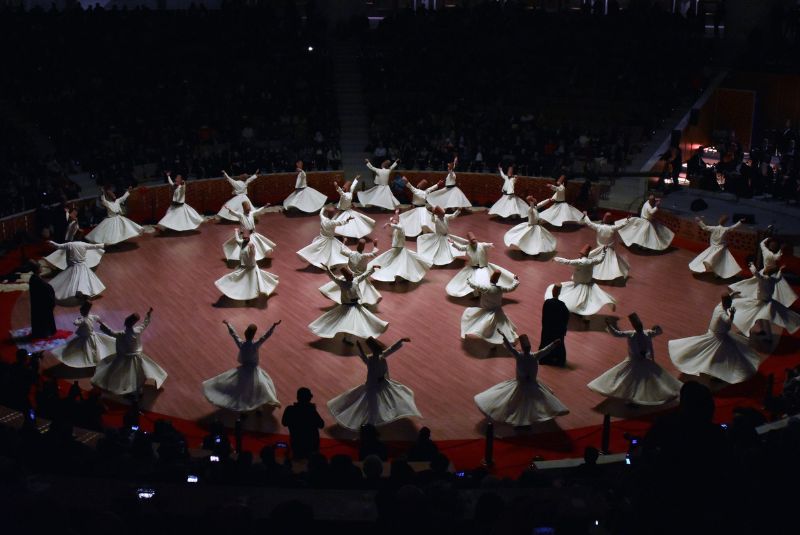
The Role of a "Sheikh" in Guiding the Participants
The Sheikh, or spiritual guide, plays a pivotal role in guiding the participants of Sama dance. The Sheikh is a respected figure within the Sufi tradition, possessing deep spiritual insight and knowledge. Their role extends beyond mere instruction on dance techniques; they act as mentors, supporting the spiritual growth and transformation of the dancers.
Before the Sama ceremony, the Sheikh imparts spiritual teachings and conducts spiritual practices with the participants, preparing them for the profound experience of the dance. During the performance, the Sheikh leads the ceremony, guiding the dervishes with prayers and meditative invocations, helping them maintain their spiritual focus and connection with the divine.
The Sheikh's presence ensures that the Sama dance remains a sacred and authentic ritual, fostering an atmosphere of reverence and devotion for both the participants and the audience. Their wisdom and guidance contribute to the transformative power of the Sama dance, making it not just a performance but a deeply spiritual journey toward unity with the divine.
| Find more: Chaharshanbe Suri: The Festival of Fire and Renewal in Iran
Sama Dance in Other Countries
Sama Dance in Turkey: Konya and Mevlevi Order
Iran stands as the heartland of the Sama dance, as we know Persia is the origin of this spiritual dance. However, Konya, Turkey is the spiritual home of the renowned Mevlevi Order, which was founded by the esteemed Persian Sufi poet Mevlana Jalaluddin Rumi in the 13th century. The city serves as a pilgrimage site for Sama enthusiasts, drawing visitors from across the globe to witness the enchanting Sama ceremonies held in the iconic Mevlana Museum, the final resting place of Molana (Mevlevi).
The Sama dance performances in Konya are a blend of mysticism and artistic finesse. They stay true to the traditional Mevlevi rituals, preserving the ancient techniques of whirling and music. Tourists and spiritual seekers alike flock to Konya to experience the profound spirituality and cultural heritage of Sama dance in its most authentic form.
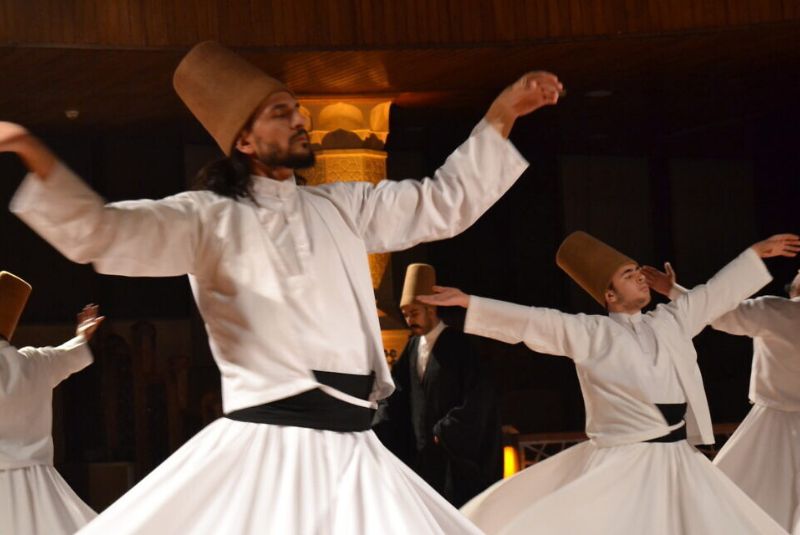
Sama Dance in Other Parts of the Middle East
Beyond Iran, Sama dance has also found a home in various other parts of the Middle East. Countries such as Syria, Egypt, and Iraq have their own unique interpretations of Sama dance, reflecting the diverse cultural influences and Sufi traditions in these regions. In Syria and Egypt, Sama ceremonies are held by Sufi communities as an expression of their spiritual devotion and connection to the divine.
Influence and Global Spread of Sama Dance
The allure of Sama dance has transcended geographical boundaries, captivating audiences far beyond the Middle East. Its influence has reached every corner of the world, inspiring artists, musicians, and spiritual seekers from diverse cultural backgrounds.
Throughout history, renowned artists and performers have drawn inspiration from Sama dance, incorporating its symbolism and spiritual essence into their artistic expressions. Painters, poets, and musicians have paid tribute to this mystical dance form, bringing its beauty to a broader audience and further fueling its global spread.
| Discover: All About Nowruz!
Final Words
In the enchanting realm of Sufi spirituality, Sama dance stands as a timeless expression of devotion and unity with the divine. Rooted in the mystical teachings of Mevlana Jalaluddin Rumi and other esteemed Sufi poets, Sama dance has traversed centuries and borders to touch the souls of seekers worldwide. At its heart, the Sama dance symbolizes the profound journey of the soul toward spiritual enlightenment, transcending the mundane and seeking unity with the divine source.
As we embrace the mystique of Sama dance, let us recognize its enduring spiritual significance and its capacity to inspire souls across cultures and generations. Let us approach this ancient art form with reverence and humility, honoring its origins and preserving its authenticity for future generations to experience its transformative magic.
Share your story!
Comment below and let us know about your Experience.
Your story inspires others!


Comment
Leave a Comment